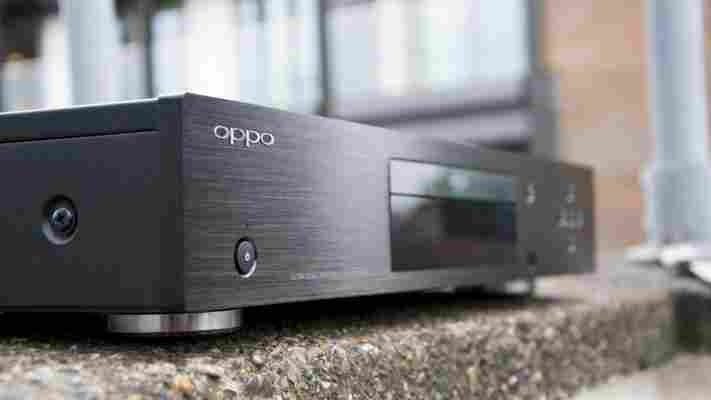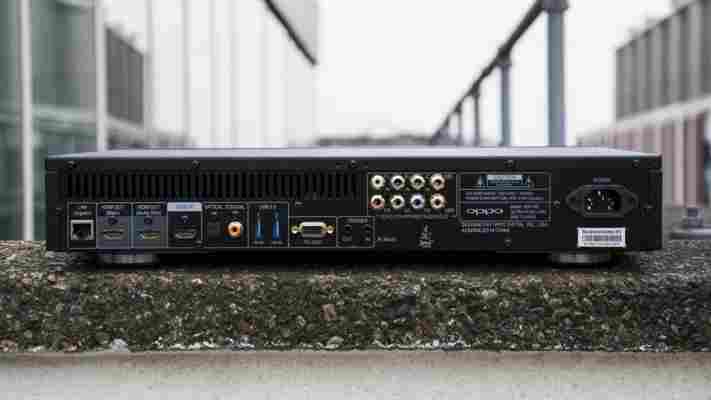If you’re looking to playback an Ultra HD 4K Blu-ray film, there’s only a handful of players to choose from. Oppo, the Chinese electronics manufacturer and highly respected in the industry for its high-end players disc spinners, is the latest to join the party.
The Oppo UDP-203 is a UHD 4K Blu-ray player that has support for RGB and YCbCr colour spaces, Dolby Atmos, DTS:X, PCM and Bitstream audio formats, plus HDR10, and Dolby Vision HDR coming soon through a firmware update. With a long list of features, can the £650 Blu-ray player prove to be worth the high price?
READ NEXT: Best TV 2017 - The best televisions to buy
Oppo UDP-203 review: Tl;dr
Although there aren't many players on the market competition is stiff, but the UDP-203 offers something different. It's crammed with features and it’s one of the most complete players you can find on the market today.
The big sticking point is the price, which at £650 makes it three times dearer than the Xbox One S and more expensive than every other dedicated 4K Blu-ray player on the market. Its comprehensive feature set means it will appeal only to dedicated videophiles.

READ NEXT: What size TV should I buy?
Oppo UDP-203 review: Price and competition
The UDP-203 isn’t cheap. At £650 from Amazon (a lot cheaper in the US at $550 ) it’s more than three times the price of the Microsoft Xbox One S (£200) .
It’s also significantly more expensive than its main rivals, the Panasonic DMP-UB900EBK (£380) and the Samsung UBDK8500 (£215) Blu-ray players, both of which are highly regarded.


READ NEXT: Samsung UBD-K8500 review - 4K Blu-ray for the masses?
Oppo UDP-203 review: Features, design and build quality
The player is visually stunning and will fit into any living room space. With a brushed aluminium front panel, a full metal chassis and metal feet, the UDP-203 looks great. At the front there’s an on/off button, a dimmable LED display, an eject button, a USB port for playing media from a flash drive and a set of media transport buttons.
Around the back is a hugely impressive selection of ports. You get two HDMI outputs (one 1.4 for audio only and the other 2.0 for video and audio) and a single HDMI 2.0 input with HDCP 2.2, so you can hook up a Chromecast or Amazon Fire Stick to add smart features. There are optical and coaxial digital audio outputs, a pair of USB 3.0 ports for connecting hard disks and thumb drives and eight phono output ports for surround sound connection to older home theatre receivers.

The UDP-203 will, of course, play 4K and Full HD Blu-rays, the latter in both 2D and 3D, but its capabilities don’t stop at that. It will also play DVDs, CDs, DVD-audio, AVCHD files, Kodak Picture CD and SACDs. The selection of formats and discs play to the Oppo’s advantage, especially over the Panasonic UB900 , which isn’t capable of playing nearly as wide a selection formats.
In addition to the video and audio connections, the Oppo also has Ethernet and 802.11ac Wi-Fi built-in, which you can use to stream video content from a NAS drive or other shared storage and update the firmware. And its chunky, infrared remote is as well- thought out and comprehensive as its array of connectivity. I particularly like that the keys are backlit.
Colour spaces are another plus point for the Oppo and with both RGB (PC and video) and YCbCr (4:4:4, 4:2:2 and 4:2:0) support at 8-, 10- and 12-bit there’s lots to choose from. HDR is a must-have and thankfully the UDP-203 comes with full HDR 10 support and, better still, later in the year it’ll have Dolby Vision HDR support through a firmware update.
This is something that’ll excite a few videophiles as the upgraded HDR format is set to bring more life and colour to movies by offering 12-bit playback and up to 10,000 nits of brightness.
Currently, HDR 10 is capable of 1,000 nits, which means Dolby Vision HDR will provide a higher dynamic range on capable TVs. Even though there aren’t any displays capable of displaying 10,000 nits, the new technology does future proof the UDP-203. No other player has this capability, either currently or planned, so it’s good to see Oppo bringing a degree of future proofing to its player.
Audiophiles will also be pleased about the Oppo’s DAC, which is a 32-bit AKM AK4458VN. This eight-channel DAC enables 192 kHz/32-bit PCM and multi-channel DSD64/128 playback and also supports Dolby Atmos and DTS:X into the bargain, making it ideal for serious home theatre installations.
READ NEXT: Dolby Vision vs HDR 10 - what's the difference?
Oppo UDP-203 review: Software and firmware
I was impressed by the Oppo UDP-203’s settings menus, which provide a wide variety of options to delve into. This includes manually forcing the player to output HDR – a small, but useful feature to include, as not every TV automatically recognises HDR content. Another useful feature is its upscaling capability, which allows you to play a Full HD (1,920 x 1,080) film or a DVD in 4K (3,840 x 2,160).
Through the settings you can change the audio output (including forcing a Bitstream or PCM output), manually set the aspect ratio, resolution, frame rate, colour depth and even the colour space. This makes it one of the most fully featured 4K UHD Blu-ray players on the market. By comparison, the Xbox One S has only a handful of features and settings to choose from. Granted, most won’t need to fiddle with these options, but it does lend the player the flexibility to suit any setting.
On a negative note, the menus were a little laggy and I was also disappointed to find no built-in streaming apps. Despite its connectivity options, the Chinese manufacturer has opted against including either Netflix or Amazon streaming.
READ NEXT: The BEST soundbars of 2017: Boost your TV audio
Oppo UDP-203 review: Performance
Powered by a MediaTek OP8591 quad-core CPU, the Oppo UDP-203 is smooth and responsive in operation, no matter what you throw at it. In fact, coupled with its custom-made 4K loader (its Blu-ray tray) , the UDP-203 loads and seeks movies such as The Revenant (4K UHD Blu-ray) , Star Trek Beyond (4K UHD Blu-ray) and Transformers: Age of Extinction (FHD Blu-ray) far quicker than an Xbox One S .
The MediaTek OP8591 processor also provides a jitter and stutter-free playback.
The player is silent, too. I was barely able to make out the disc spinning and with no audible fan noise there’s nothing to interrupt your listening pleasure.
Video quality is superb. Action scenes in The Revenant are perfectly showcased and accurately portrayed. I am particularly fond of its HDR capabilities, that brought out details in demanding scenes. For example, blue skies appearing as they should alongside forestry.
Colours are vibrant yet natural-looking. I found the gloomy colours in The Revenant and the popping scenes from Star Trek Beyond were portrayed superbly and with a pool of colour spaces and depths to choose from, you can align the player’s capabilities with the film you pop into the loader.
Compared with the Xbox One S, colours were slightly more refined and a touch more vibrant. This is most apparent in the final scenes of The Revenant , with the trail of blood on the snow thick with texture and the wind-worn faces on the Native Americans alive with craggy detail.
Moving on to the player’s audio capabilities, I had no problems with any delay (lip-sync) or the quality throughout different scenes. Audio is correctly reproduced with a full-bodied sound throughout the frequency range.
READ NEXT: Panasonic DMP-UB900 review
Oppo UDP-203 review: Verdict
The Oppo UDP-203 is undoubtedly the most capable 4K Blu-ray player on the market. It’s stacked with features, supports every imaginable standard and type of connection and it looks and sounds fantastic.
The big question I wanted to answer in this review, though, is whether the Oppo UDP-203 was worth three times of an Xbox One S? The short answer to this is no, not for most people anyway.
Despite the Xbox One S having a slightly slower performance, fewer settings, and image quality looking a touch less vibrant, these aren’t things that justify the radical price difference, and neither are the extra features and connectivity options – unless you desperately need analogue outputs, that is.
If you’re looking for a dedicated 4K UHD Blu-ray player, both the Panasonic DMP-UB900EBK (£380) and Samsung UBDK8500 (£215) offer much better value for money. Sure, they don’t have Dolby Vision HDR support, and probably won’t in the future either, but they’ll offer the same level of customisation and performance, if not the same broad scope of connectivity, while costing a fraction of the price.
